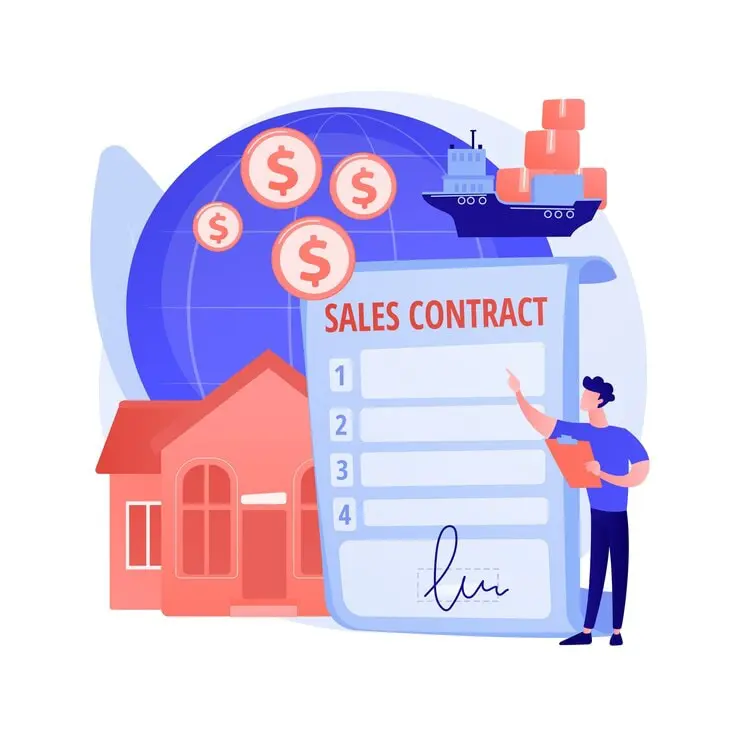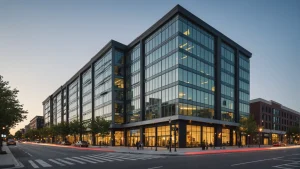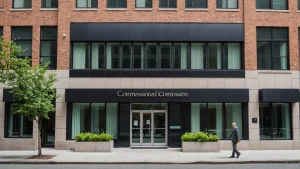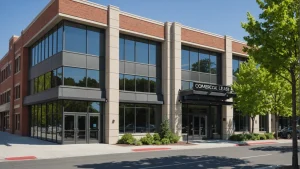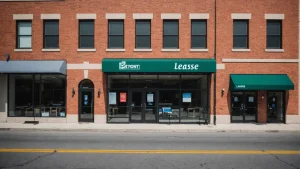A business owner signed a commercial lease without reading the terms. Six months later, his profits dropped by 40% because he didn’t understand that the types of commercial leases could affect his bottom line, and that his lease required paying a percentage of sales to the landlord.
This happens more than you think. The choice of a commercial lease can make or break your business profits. As Benjamin Franklin once said, “An investment in knowledge pays the best interest.”
In 2024, about 63% of business owners pay too much on their commercial leases because they don’t understand the different types of commercial leases and their impact on expenses. They sign agreements that eat into their profits when better options exist.
Think about this:
What if you could cut your business costs by 30% just by picking the right lease type?
What if you knew about building insurance that could protect your business from unexpected property tax increases?
The good news is that you have options. Five main types of commercial leases exist, each with different rules about who pays for taxes, insurance, and maintenance. Your choice affects your monthly costs, risk level, and business flexibility. Before diving into the types of leases available, it’s essential to understand what a commercial lease entails and its significance in your business operations. A thorough comprehension of a commercial lease enables business owners to negotiate better terms and avoid costly pitfalls that can arise from misunderstanding complex agreements.
Bad lease choices lead to:
- Unexpected costs that destroy profit margins
- Cash flow problems from surprise maintenance bills
- Legal issues from misunderstood responsibilities
The right lease choice leads to: Before signing any lease, it’s crucial to consider all aspects that can affect your business long term. Understanding the details of a commercial lease is essential. Make sure to consult in-depth resources and expert advice on what to be aware of when entering a lease agreement. For more insights, check out this informative article on what to pay attention to regarding a commercial lease.
Understanding all costs associated with a commercial lease is fundamental for making informed financial decisions. One important consideration is the commission that real estate agents earn for facilitating a lease agreement. This fee varies based on several factors, including the scope and duration of the contract. For a detailed breakdown, check out this informative article on the typical commission structure for a commercial lease.
Having a solid lease agreement is crucial in managing risk and protecting your investment. If you’re looking for a detailed resource, you can access a free template for a Texas commercial lease agreement. This can help guide you in formulating a lease that meets your business needs and requirements.
- Lower operating costs
- Better budget control
- Protected profits
Understanding different types of commercial leases and how they impact your business isn’t just helpful – it’s essential for survival. In this guide, we’ll break down each lease type and show you exactly how to choose the one that protects your bottom line. Before diving deeper into the specifics, it’s crucial to grasp the core meaning of a commercial lease. A well-defined understanding of a commercial lease sets the foundation for informed decision-making in your leasing journey, ensuring you make the right choices that align with your business objectives.
For a deeper understanding of the nuances between different lease types, it’s important to explore the comparison between a gross lease and a net lease. This analysis can help you determine the best fit for your business’s financial and operational strategies. You can find detailed insights on this topic in our guide on the comparison of gross lease vs net lease.
Before making any decisions, it’s vital to familiarize yourself with essential factors surrounding your lease agreement. Understanding the details of a commercial lease will prepare you for negotiations and help avoid potential pitfalls that could affect your business.

Lower your delivery costs by 23%
How we reduce costs:
- No delivery vehicle expenses
- Optimized local routes
- Pay-per-delivery model
- Average 23% delivery cost reduction
What are Types of Commercial Leases?
Understanding commercial lease is crucial: It’s key for landlords and tenants to know their rights and duties.
Adaptable agreements: Tailored to fit the needs of the business and property type.
Overview of Commercial Lease
Commercial lease types are binding contracts between a landlord and a business tenant. These agreements outline the terms and conditions under which a piece of commercial real estate leases are rented. They define both parties’ rights and responsibilities, including rent payment, maintenance, and duration of the agreement. Each lease varies depending on business requirements and property categories. These contracts are central to any business that does not own its premises, shaping the environment in which it operates.
Types of Commercial Lease
Commercial lease comes in several formats, each with unique structures and obligations. Understanding these options can help businesses find favorable lease conditions.
Triple Net Lease
A Triple Net Lease (N) is a single net lease that requires the tenant to assume the cost of property taxes, insurance, and maintenance, in addition to base rent. This single net lease type is popular in standalone properties because it reduces the landlord’s financial burden. As a result, tenants can often negotiate lower base rent. In these net leases, tenants have more control over the property’s upkeep, which can incentivize them to maintain quality standards.
Gross Lease
In a Gross Lease, the tenant-landlord pays only a fixed rent, while the landlord covers most of the additional property taxes and operating expenses, such as insurance, and maintenance. This type offers tenants stability regarding outgoings, making budgeting simpler. Gross leases are often found in multi-tenant buildings, where sharing costs among tenants can be more efficient for landlords.
Modified Gross Lease
A Modified Gross Lease blends elements from both Triple Net Lease and Gross Leases. In this setup full-service lease, tenants and landlords share operating expenses beyond the base rent. The specifics of cost-sharing vary according to negotiations, providing flexibility. These leases are a typical choice for office spaces where the division of expenses can be customized.
Benefits of Different Types Of Commercial Leases
Triple Net Lease means less stress for landlords.
Gross Leases help tenants plan better.
Modified Gross Lease offers flexibility in cost-sharing.
Triple Net Lease Benefits
Triple Net (NNN) leases provide notable predictability for landlords. Triple Net Lease shift costs like property taxes, insurance premiums, and maintenance to tenants. This absolute NNN Lease setup ensures landlords receive a more consistent income stream. This kind of Net Lease is akin to hiring a responsible caretaker for an important item. Tenants who accept this level of responsibility often handle property maintenance attentively. This absolute NNN Lease can lead to better upkeep and lower overall operating costs, such as property taxes, or the landlord.
One real-world example is large retailers like Walgreens or McDonald’s often using a N lease or net leases for their properties. These corporations prefer to have control over property taxes and costs. For investors reading this, the predictable cash flow from N leases can be appealing, especially in times of economic uncertainty. However, some hesitate due to the complexity of maintenance and costs being in the tenant’s hands. Careful assessment is key.
Gross Lease vs Net Lease
Gross leases make budgeting straightforward for tenants by bundling all expenses into one fixed rent payment. This prevents unexpected costs, enabling tenants to forecast operating expenses more accurately. In contrast, a single net lease transfers some operational responsibilities to tenants, such as property taxes and utility bills. This reduces the landlord’s management burden.
Consider a small tech startup opting for a gross lease to maintain predictable operating expenses. This ensures they can direct financial resources towards growth rather than managing fluctuating costs. However, they might face higher premiums due to the landlord padding expenses for potential risk.
As interest rates and economic conditions fluctuate, both landlords and tenants aim for stability. Gross leases offer simplicity but can be costlier overall. Comparing these two approaches involves balancing the ease of budgeting with financial obligations.
Modified Gross Leases Flexibility
Modified gross lease offer a versatile approach to commercial leasing. By allowing landlords and tenants to negotiate which expenses each party covers, it balances risk and responsibility. This adaptability makes them appealing in unpredictable markets where financial flexibility is crucial.
For example, a mid-sized law firm might choose a modified gross lease to share expenses with the landlord. This allows them to have some predictability over building expenses, while still managing certain costs directly. During negotiations, deciding who handles maintenance or utility costs can be adjusted based on each party’s financial capabilities.
While flexibility is a compelling feature, these leases can become complex. It requires both parties to maintain clear communication regarding shared obligations. One downside is potential disputes if costs and responsibilities are not carefully outlined. Balancing these factors is essential for success.
How do Commercial Lease Types Work?
Commercial lease types define terms like rent, duration, and who handles what.
They can be complex to negotiate, often with room to adjust terms.
Local laws and legal clauses play a vital role in enforcing leases.
Lease Agreements
A commercial lease agreement is a legally binding document that sets out the terms for a business to use a property owned by someone else. Important components include lease duration, rent payment specifics, and who takes care of maintenance. These commercial lease agreements also include clauses about terminating early or renewing the lease at the end. The core of a lease agreement revolves around rent—who pays it, when it’s paid, and how much it is. Rent structures can vary widely depending on the type of net lease.
Gross leases typically have tenants paying a fixed amount, while landlords cover operating expenses, making budgeting more straightforward. Net leases, on the other hand, often require tenants to shoulder certain property costs like property taxes, insurance, or upkeep. Commercial leases must be detailed because they form the blueprint for tenant-landlord interaction over potentially long periods. Failure to clearly define responsibilities and terms can lead to disputes, making a well-constructed agreement essential.
Negotiation Process
Negotiating a commercial lease is an intensive process. It’s not about haggling just over the price but covering everything from lease duration to tenant improvements. Rent is only one aspect; terms for increasing rent, subleasing rights, or responsibilities distribution are also up for negotiation. Tenants who go in prepared can often negotiate clauses that account for their specific business needs, like necessary renovations or layout adjustments. Both parties must align their interests. To enhance your negotiation skills and secure favorable terms, it’s beneficial to learn effective strategies tailored for commercial leases. Understanding key negotiation points can ensure your lease is aligned with your business goals and financial capabilities. For a comprehensive guide packed with expert advice and practical tips, consider exploring this detailed post on successful commercial lease agreement negotiation strategies.
For commercial real estate leases, for example, landlords typically seek to protect their investment and ensure a steady return, while tenants want terms that support their business operations and growth. Tenants should feel empowered to suggest amendments. Commercial lease types are negotiable, and nowhere near as rigid as they might seem initially. The balance between landlord and tenant needs makes negotiation complex yet vital.
Legal Aspects
The legal aspects of a commercial lease ensure the lease stands up in court if disputes arise. Familiarity with local property laws and regulations is essential to avoid pitfalls. These contracts must comply with local rules, including zoning laws, safety standards, and adherence to accessibility requirements such as ADA compliance. Understanding these laws is not just significant for drafting net leases but for its enforcement, especially in conflicts. Legal aspects are also important before paying property taxes.
Legal backing prevents informal agreements or misunderstandings from escalating. Clauses covering dispute resolution, indemnities, or changes in legislation affecting leases are important. They offer landlords and tenants security, knowing there’s a structured, legal framework to resolve issues or adapt to changes. Without this legal structure, the potential for conflict increases, making these legal aspects the backbone of any solid commercial lease agreement.
Lease Structures and Types of Commercial Leases
There are different structures like a gross, single net lease, each with specific characteristics. A gross lease involves a single, usually higher, rental payment that covers most expenses. It’s straightforward but can hide higher costs. A net lease breaks down these costs, with tenants covering expenses like property taxes or maintenance. There’s also the percentage lease, popular in retail, where tenants pay a base rent plus a percentage lease of sales. Knowing these structures helps tailor the leasing choice to business needs.
Implementation and Renewal
Implementation involves signing the lease and adhering to its terms. Initial stages might include property inspections, confirming that improvements or repairs discussed during negotiation are completed. The lease effective date starts the timeline for these responsibilities, like paying rent and maintaining the property. Renewals, on the other hand, are crucial to long-term planning. They can be pre-set in the lease or require renegotiation closer to the end date.
Whether for stability or flexibility, renewal options must be clear to avoid surprises. Knowing your renewal options means businesses can plan their future with more certainty, adapting as they grow or as market conditions change. A well-crafted renewal clause gives both tenant and landlord more security and foresight into their leasing future.
How to Choose the Right Lease Type
Understand your business needs.
Analyze location, consult experts, and compare costs.
Find a lease that aligns with financial and strategic goals.
Evaluate Business Needs
Understanding your specific business needs is crucial. Different businesses have different space requirements. For instance, a retail store may need a location that attracts foot traffic, while an office for a tech startup might prioritize proximity to transit options or skilled labor pools. Knowing your type of business helps in identifying the lease that caters to your needs.
Also, think about your revenue model. If you have predictable sales cycles, a fixed-cost lease like a gross lease might be beneficial. However, businesses with fluctuating revenues could benefit from a percentage lease, where rent payments align with income.
Analyze Property Location and Type
The location of your business dictates the lease type that might be best. Properties in high-traffic areas often suit percentage leases because they link rent to sales volume. Office locations might be better with gross or modified gross leases due to shared operating expenses and simplified budgeting.
Consider the property type. Retail spaces, warehouse facilities, and office buildings each pair well with different lease types. A warehouse might require a net lease where the tenant pays rent and manages utilities, insurance, and maintenance, allowing control over specific costs.
Consult with Professionals
Engage real estate agents and legal advisors for commercial real estate leases. Their expertise can clarify complex aspects of leases and ensure the terms support your business strategy. They bring experience in negotiations and might reveal options you hadn’t considered.
You should make sure the net lease terms align with your broader business strategy and financial capacity. Professionals help customize lease agreements to fit cash flows and operational plans, allowing seamless integration of the lease into your business due to their understanding of local markets and legal contexts.
What is the Best Commercial Lease Type for Your Business?
Tailor net leases to align with growth and financial plans.
Evaluate cash flows before committing.
Plan for growth with flexible terms.
Align with Business Objectives
Choosing the best commercial lease for your business ties directly to what your company aims to achieve. This starts with understanding the nature and growth trajectory of your business. For example, a tech startup might lean towards a gross or double net lease for simplicity in budgeting, while a large retail chain might prefer a triple net lease for cost control. It is better to opt for net leases that support your growth. This means not just meeting current needs but also considering how this choice impacts future objectives.
Assess Financial Stability
Financial stability assessment is crucial. A lease must match your financial limits. It is better to start by evaluating if the structure imposes a sustainable cash flow. Consider using detailed financial forecasting methodologies, which are widely discussed in financial management literature.
Plan for the Future
Future-proofing is a vital aspect of lease planning. Leases that offer options for expansion or relocation provide security against growth hindrances. Knowing terms allows for strategic planning. Flexibility in terms like lease renewal, expansion, or sublease can significantly impact business agility.
It’s important to also anticipate changes in rent dues or maintenance costs as market conditions fluctuate. Houses such as law firms seeking predictability in costs often engage in modified gross leases to balance expenses with landlords. These structures allow for evolving needs without breaching financial limits. Being proactive about potential changes allows businesses to respond to market demands swiftly and efficiently.
Evaluate Options with Professional Guidance about Types of Commercial Leases
Professional insights are key when evaluating commercial property leasing options. Collaboration with real estate experts and legal counsel can sharpen negotiation tactics about commercial real estate leases. For additional guidance, you can apply model lease analytics from sources such as the Real Estate Guidebook. Having advisors who recognize the nuances can lead to lease terms that are significantly in your favor.
Negotiating advantageous terms is a skill, fortified by extensive record-keeping. Metrics like occupancy costs provide leverage in negotiations. Regularly update these records for ongoing negotiations. Understanding both sides helps move closer to agreements that favor business interests. The strategic interplay of lease choice, business objectives, and legal guidance can provide unmatched growth potential for your business.

